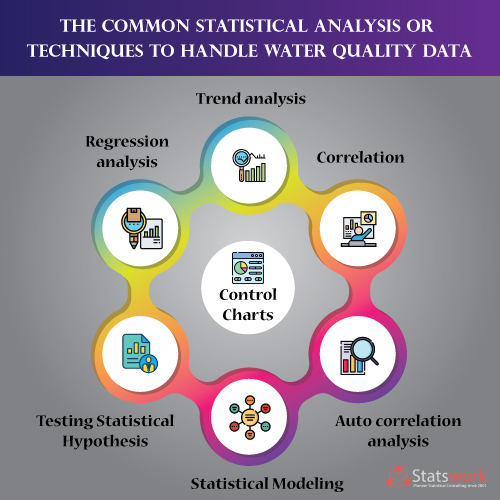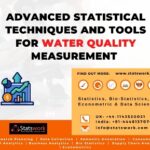Applications of Statistical Analyses on Water Quality data and its recent research trends
Introduction
Analysing water quality data entails reviewing and assessing the data to see if any errors were made during the sampling or analysis of the water quality sample or data entry. To detect any issues regarding data, a series of data checks should be performed. It includes data checking in the first stage, i.e. data entry, whether the data is within the range of parameters, data is within the detection limits, etc. However, there are different aspects of water quality, and the techniques suitable for each field are tabulated in the following subsection. One way to analyse the water quality data is using graphical techniques. The benefits of graphical representation of data include finding the data trend, finding outliers in the data, etc.
Statistical Techniques
The common statistical analysis or techniques to handle water quality data is as follows:
| Statistical Technique | Commonly applied to |
| Trend analysis | Rainfall |
| Correlation | Flowing quality of water on any surface, drinking water quality |
| Regression analysis | Sanitary water quality |
| Autocorrelation analysis | Water quality measured at several point of time |
| Testing Statistical Hypothesis | Comparing the water quality of two or more rivers or regions |
| Statistical Modeling | Predicting future outcome like rainfall prediction, etc. |
| Control Charts | Quality of water is under control limits or not. |
- Trend analysis:
It acts as an important factor for water quality analysis since it helps the researcher understand the data’s variability. Wang et al. (2020) proposed an innovative trend analysis to detect or identify the annual and seasonal rainfall pattern. Data collection from different meteorological stations and compare the proposed method with Theil-Sen trend method Mann-Kendall test.
The result revealed a strong trend associated with flood and drought during extreme rainfall. These methods’ validity showed that the proposed method detects the seasonal trend accurately than using the other two test methods. Our Data collection service help in collect clean data and maximize your impact.

- Correlation:
Correlation is basically to identify the relationship between two or more variables. It helps to identify the variables which control the variability in water quality data.
For example, consider a study on water flowing quality on land, i.e. water quality in the rivers. One can take different research problem based on the river data. However, suppose our interest is to find the seasonality of water quality in selected areas and the land usage.
Then common statistical technique to analyse the data is using Spearman’s rank correlation coefficients. It can identify the relationship between the water quality parameters and the various land usage at different times.
The correlation matrix will look like the following table 1.
Table 1: Sample Correlation Matrix
| X/Y | A | B | C |
| A | 1.00 | 0.34 | 0.72 |
| B | 1.00 | 0.80 | |
| C | 1.00 |
- Regression analysis: Regression analysis helps find the average relationship between the variables and is useful to predict future outcomes.
- Autocorrelation analysis: If we want to understand the relationship between two or more similar attributes measured at different time points, then autocorrelation analysis can be used.
- Testing statistical hypothesis
- Statistical modeling: It is used to identify the behavior and predict future outcomes through a mathematical formulation.
- Control Charts: It is used to monitor the process and detect the data variability using control limits. The most popular are the mean chart and range chart. If any data points are scattered away from the limits, they can be considered defective and treated as an outlier(s).
However, selecting a suitable statistical analysis or water quality analysis technique depends on the data and the research question. The choice of suitable analytical technique is based on detection limits, i.e. range of concentration of the chemical component in the water, how much accuracy and precision are needed for the research problem. The most important is the sampling strategy. Statswork provide suitable online statistical analysis service to get high quality data.
Future Scope
There are numerous statistical procedures or techniques to analyse the water quality data. Since water scarcity is increasing due to lack of rainfall in many regions, finding the water quality for the recycled water, research related to turning the hard water to soft water, etc. are considered future research scope.
References:
- Al Saad Z.A.A., Hamdan A.N. (2020) Evaluation of Water Treatment Plants Quality in Basrah Province, by Factor and Cluster Analysis. Journal of Water and Land Development. 46 (VII–IX) pp. 10–19.
- Yuefeng Wang, Youpeng Xu, Hossein Tabari, Jie Wang, Qiang Wang, Song Song, Zunle Hu. (2020). Innovative Trend Analysis of Annual and Seasonal Rainfall in the Yangtze River Delta, Eastern China, Atmospheric Research, 231, 104673.
- Tommaso Caloiero (2020). Evaluation of Rainfall Trends in the South Island of New Zealand
through the Innovative Trend Analysis (ITA). Theoretical and Applied Climatology, 139, pp. 493–504.
- Fikret Ustaoğlu, Yalçın Tepe, Beyhan Taş, (2020). Assessment of stream quality and health risk in a subtropical Turkey river system: A combined approach using statistical analysis and water quality index, Ecological Indicators, 113, pp. 1 – 12.
- Emma R. Kelly, Ryan Cronk, Emily Kumpel, Guy Howard, Jamie Bartram, (2020). How we assess water safety: A critical review of sanitary inspection and water quality analysis, Science of The Total Environment, 718, pp. 1 – 9.



 Previous Post
Previous Post Next Post
Next Post